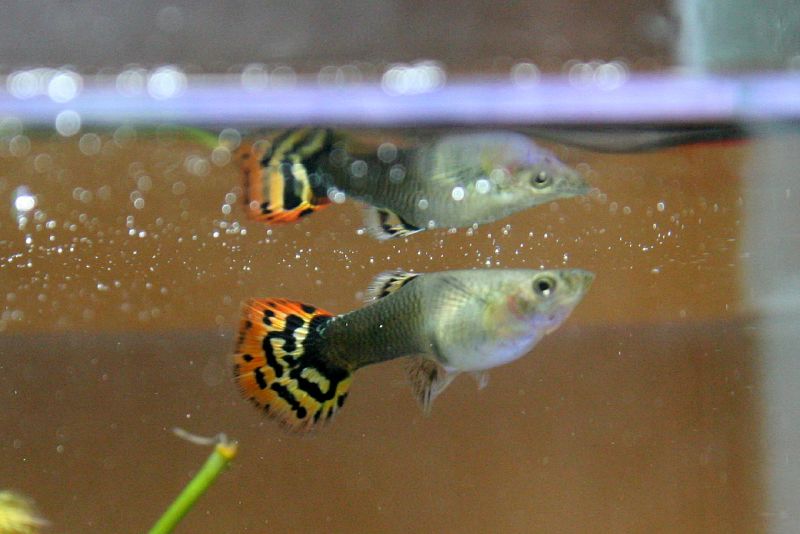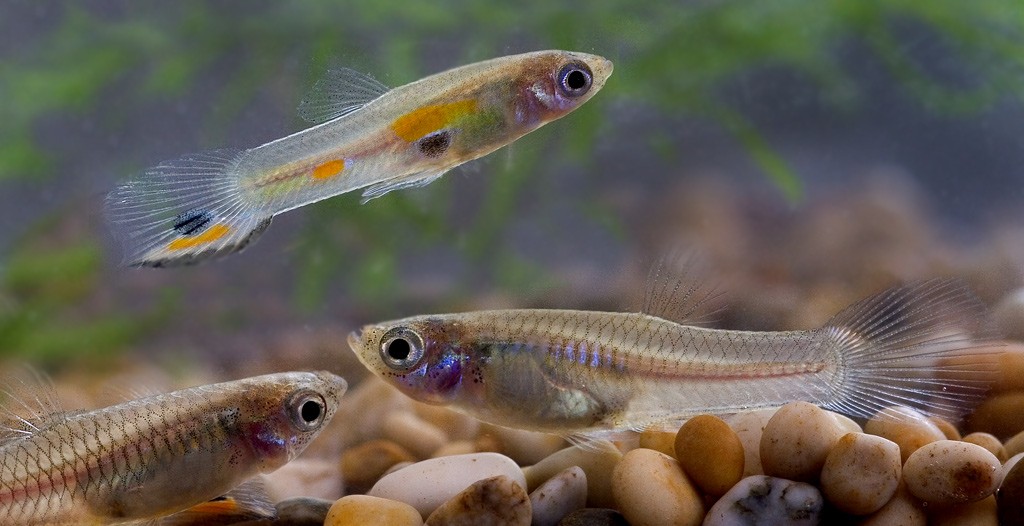If you have (or are looking at getting) an aquarium, you’ve probably considered investing in a guppy.

Guppies are one of the most popular aquarium fish, as they’re small and look very pretty, but anytime you’re seeking out a pet, you should learn how to take care of it first.
Here’s all you need to know about guppies before you take them home!
Contents
Guppy Fish Appearance
Size and Price
Guppies are relatively small fish; a fully matured guppy will be between 1.5 and 2 inches, with males generally being smaller than the females.
Guppy fish are relatively cheap to purchase which makes it a great starter fish. Common guppies will cost a couple of dollars each, though rare and special guppies can cost hundreds of dollars.
Guppies have a relatively short lifespan; usually you can expect a guppy to live for about two years.
In addition, guppies are very social fish, so most experts recommend keeping guppies in trios. If you’re okay with your guppies breeding – or are specifically looking to raise a collection – you should keep them in a 1:2 male-female ratio.
However, if you’d rather keep the trio solo, it’s wise to invest exclusively in male guppies.
As mentioned, guppies are very social fish, so if you want to add different species to your collection, be sure to find those which possess a similar temperament.
Appropriate tank mates are Molly fish, Platies, and Gouramis. Other types are acceptable as well, but can easily bully the guppies, so it may not be safe.
Sickness
For the most part, guppies don’t get sick easily. However, there are a few more common illnesses that you should be on the lookout for.
Ich is likely the most common disease; it’s distinguishable by small white spots appearing on the fish’s skin and fins. They may start rubbing their skin against surfaces in their aquarium, and generally will have a loss of appetite.
Usually, this is caused by quick temperature and pH changes, but can be a sign of poor-quality water, so make sure to clean your tank correctly. There are medications available at pet stores to easily treat the disease.
Fin or tail rot is also an occasional issue for guppies; the fins or tail will look shredded or disintegrated, oftentimes with discolouration around the holes.
This can also be caused by poor-quality water, but most of the time, it’s because of a bacterial infection that happened after another fish nipped the guppy’s fins.
You can treat this issue with an antibiotic. Afterwards, be sure your tank is not overcrowded and is filled with decorations guppies can hide in; this will prevent future attacks that could lead to more infections.
There are other potential illnesses for guppies, but these are the most common. Be sure to observe your fish frequently, and if you notice any differences in their behavior, look it up right away! It could be nothing, or it could be something that needs treatment as quickly as possible.
Guppy Babies
If you have male and female guppies in the same aquarium, you’ll almost definitely have to deal with breeding.
Unlike some other species of fish, guppies give birth to live young, so if you haven’t noticed the pregnancy beforehand, you’ll be able to see the young – called “fry” – immediately.
If you’re observing the guppies frequently, you’ll be able to identify a pregnancy by a dark spot on the pregnant female’s abdomen, and her abdomen will grow larger.

Breeding guppies is quite the undertaking, so most beginners won’t want to keep males and females in the same aquarium. However, if you do, you’ll want to use a breeder box, which is a small plastic box that floats in the aquarium.
The pregnant female is placed in the box soon before the birth, and the fry will be dropped into a special area to keep them safe or to discard soon after birth.
Guppies can have between two and 200 fry at once, so you’ll need to do a lot of research before taking on this endeavour.
Guppy Fish Care
Tank Requirements
The aquarium you choose for them should be relatively large. Very small containers are not acceptable for any fish, so a trio of guppies will likely use a five-gallon tank, and six guppies should probably be in a 10-gallon tank.
Any more than that should use the ‘one inch of fish to one gallon of water’ rule of thumb.
When it comes to keeping your tank well lit, it’s wise to invest in timed light. Guppies need at least eight hours of darkness per day, so it’s very important that they’re not over exposed. As it’s easy to forget this detail, a timed light will keep them in optimal health.

While using sunlight may seem like the right choice for this issue, that’s actually quite dangerous. Direct sunlight can overheat the water, so a better option is to have an artificial light above the tank.
Tank Set-Up
Once you’ve bought an appropriately sized aquarium for the guppies, you’re only halfway there! You’ll need a setup with good bacteria and filtration that your guppies can quickly adapt to.
The easiest way to jump-start a bacteria cycle is by taking a used filter pad from someone who already has guppies and running it through your filter for a few hours.
You’ll also want to add plants and decorations to your aquarium. Gravel is a good option for covering the bottom of the aquarium, and you’ll want lots of live plants to assist with filtration.
Don’t just take rocks and plants from nature, as there’s no way to make sure they’re completely clean, and they can introduce parasites and harmful bacteria to your aquarium.
Decorations from your local pet supply store are cheap and will be much safer for your guppies.
Here’s an example of a Guppy tank set-up.
Water requirements
Guppies originate from the Amazon river, which means their most comfortable habitat is water that mimics those conditions.
Your tank should stay at a temperature of 75-85 degrees Fahrenheit (24-30 degrees Celsius), which means you’ll require a water heater and thermometer to keep the environment in check.
In addition, you’ll need to dechlorinate and monitor the pH level of your aquarium. Water conditioner, which can be bought at your local pet supply store, will help with both of these, and you can monitor pH levels with a pH testing kit.
Ideally, your pH level should be between 6.8 and 7.8.
Tank Maintenance
Consistency is very important with guppies. Make sure the temperature and pH of your aquarium stays generally the same as rapid fluctuation of water temperature can cause significant health problems.
Again, a thermometer is very helpful here, because water heaters can occasionally malfunction.
You should also change the water frequently. At the very least, you should be changing approximately 30% of the water every five days, though some people recommend changing 10% of the water every day.
Introducing the Guppies to the Aquarium
Congratulations; you’ve finally completed all the ground work and can proceed with introducing the guppies to their new home. While they’re a fairly resilient species, there are still issues to watch out for..
Guppies aren’t particularly difficult to introduce to their new habitat. Make sure you’ve set the aquarium up properly, with the right temperature, pH, and bacteria.
Turn off the aquarium lights and place the sealed bag containing your fish from the pet store into the aquarium, floating at the top for fifteen minutes to adjust the water temperature. This will make the transition as easy as possible.
Cut open the bag close to the top, and begin adding half a cup of aquarium water to the bag every four minutes until the bag is full. Discard half of the water from the bag, then repeat, adding half a cup every four minutes until the bag is full again.
Take an aquarium net and move the fish from the bag to the aquarium, then discard the bag, including the water inside.
Be sure to watch your guppies carefully for the first few weeks, making sure they don’t seem sluggish and aren’t developing new patterns on their scales, as that can be indicative of a problem.
Feeding Your Guppies
Feeding is easily one of the most important things with your guppies. Obviously, if you don’t feed them enough, they’ll quickly get sick, but overfeeding is just as bad.
The best thing to do is to feed them small amounts a few times a day, rather than a large amount once a day.
Your guppies should eat all their food within a few minutes. If it takes them more than about five or six minutes to eat, or extra food ends up floating in their tank, you should scoop out those excess bits and make sure to feed them less the next time.
In the wild, guppies eat live food, mostly brine shrimp, and these are much preferable to fish food. However, if you’re not able to find fresh or freeze-dried shrimp, fish food can be nutritional as well.
Fish food is available at many pet stores, but make sure you’re getting high-quality flakes. Some low-quality fish flakes will be made with a great deal of filler, and your guppies won’t get the nutrients they need to stay healthy and happy.
Keeping Guppy Fish
Guppies are one of the easiest and most rewarding fish to take care of.
They’re adaptive and resilient, and their colourful patterns can be fun to watch as they swim around in your aquarium.
As long as you pay attention and care for them well, they’re an excellent beginners’ pet to have.
Do you own any Guppy Fish?



